2023-03-01 スイス連邦工科大学ローザンヌ校(EPFL)
<関連情報>
- https://actu.epfl.ch/news/glacier-shrinkage-is-causing-a-green-transition/
- https://royalsocietypublishing.org/doi/10.1098/rsos.230329
「月の山」の暗い面:アフリカ最後の氷河渓流のひとつにおけるマイクロバイオームの構造と機能に関する初の知見 The dark side of the moon: first insights into the microbiome structure and function of one of the last glacier-fed streams in Africa
Grégoire Michoud,Tyler J. Kohler,Leïla Ezzat,Hannes Peter,Juliet Kigongo Nattabi,Rosemary Nalwanga,Paraskevi Pramateftaki,Michail Styllas,Matteo Tolosano,Vincent De Staercke,Martina Schön,Ramona Marasco,…
Royal Society Open Science Published:09 August 2023
DOI:https://doi.org/10.1098/rsos.230329

Abstract
The glaciers on Africa’s ‘Mountains of the Moon’ (Rwenzori National Park, Uganda) are predicted to disappear within the next decades owing to climate change. Consequently, the glacier-fed streams (GFSs) that drain them will vanish, along with their resident microbial communities. Despite the relevance of microbial communities for performing ecosystem processes in equatorial GFSs, their ecology remains understudied. Here, we show that the benthic microbiome from the Mt. Stanley GFS is distinct at several levels from other GFSs. Specifically, several novel taxa were present, and usually common groups such as Chrysophytes and Polaromonas exhibited lower relative abundances compared to higher-latitude GFSs, while cyanobacteria and diatoms were more abundant. The rich primary producer community in this GFS likely results from the greater environmental stability of the Afrotropics, and accordingly, heterotrophic processes dominated in the bacterial community. Metagenomics revealed that almost all prokaryotes in the Mt. Stanley GFS are capable of organic carbon oxidation, while greater than 80% have the potential for fermentation and acetate oxidation. Our findings suggest a close coupling between photoautotrophs and other microbes in this GFS, and provide a glimpse into the future for high-latitude GFSs globally where primary production is projected to increase with ongoing glacier shrinkage.



